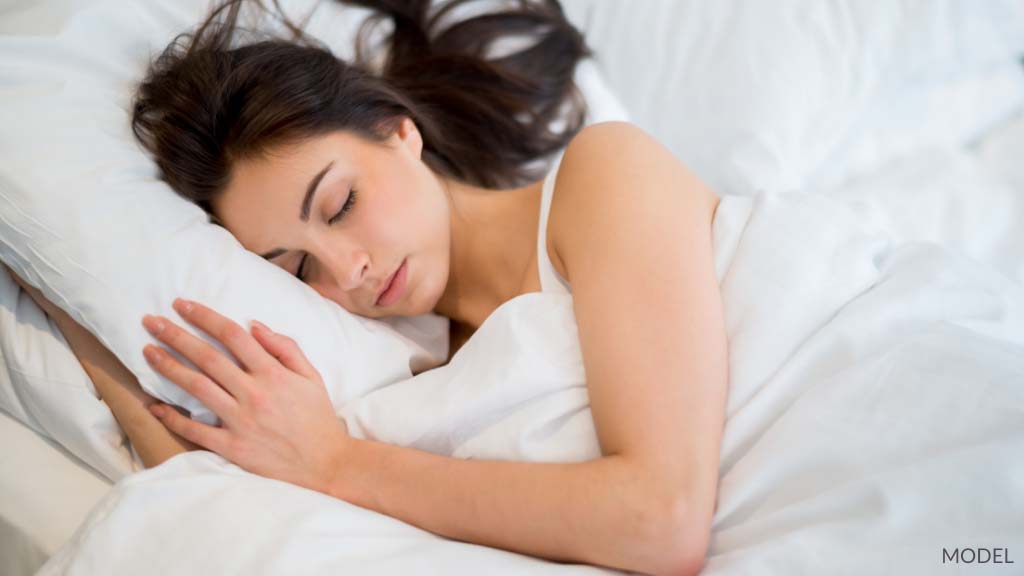Getting enough sleep after breast augmentation is essential to the recovery process. Women used to sleeping on their sides, however, are often worried about adjusting their sleep positions and getting the rest they need. Even though sleeping after breast augmentation may be challenging at first, following the tips included in this blog post can help you comfortably rest until you’re cleared to sleep on your side.
Why Is Sleep So Important After Surgery?
Surgical recovery places extra demands on your body, often leaving you fatigued in the days after the procedure. When your body is tired, its immune system needs the boost provided by sound sleep. Additionally, when the body is relatively still during sleep, it can send more blood to the muscles and tissues injured during the surgery, delivering oxygen and nutrients to promote healing.
In addition to helping strengthen your immune system, more sleep may equal less pain during your recovery. The National Sleep Foundation recommends adults get 7 to 9 hours of sleep each night. The amount should increase when you’re recovering from breast augmentation surgery.
Sleep Position Is Important After Breast Augmentation
Sleeping in a recliner or on your back with your upper body elevated helps reduce swelling, enhances blood circulation, and keeps your breasts in a more natural position as they heal. These positions also make it easier to get up without straining your chest and arm muscles. It’s important to avoid using your arm and chest muscles during recovery, and sleeping flat on your back requires upper body strength to get out of bed. If you don’t have a recliner, make sure you have enough comfortable pillows to keep your upper body elevated.
Most patients can return to sleeping flat on their backs once they feel comfortable doing so—which typically occurs several days after the surgery. You still need to avoid sleeping on your side or rolling onto your side while you’re sleeping. That’s because a side-sleeping position puts pressure on the implant and incisions while they’re still healing, which can compromise the results. You can expect to sleep on your back during the first 2 weeks of recovery. Avoid sleeping on your stomach until I give you the go-ahead.
Get Used To Sleeping on Your Back Before Surgery
If you typically sleep on your side, changing that habit isn’t easy. Waiting until after getting breast implants to start sleeping on your back is difficult. You can get used to sleeping on your back propped up with pillows for at least a week before your surgery date.
Here’s how:
- Place extra pillows on your bed to help keep your body positioned correctly. Placing a pillow under each arm is one way people successfully transition to sleeping on their backs.
- Having a pillow under your knees helps maintain the proper alignment of your back. It can also help if you experience lower back discomfort.
- Be persistent. If you catch yourself on your side or stomach, roll onto your back.
- Special pillows can prevent your head from rolling to one side and provide good support.
Even though you can return to sleeping on your side after the initial recovery stage, sleeping on your back helps prevent neck and back pain by keeping your head in a neutral position. Additionally, sleeping on your side can contribute to the development of lines and wrinkles.
What Are Other Tips for Sleeping After Surgery?
Following these tips can help you get the sleep you need after breast augmentation:
- Take a warm shower (not a bath) in the evening to help you relax.
- Take short walks throughout the day to boost circulation and reduce the risk of developing blood clots.
- Avoid caffeine, alcohol, sugar, and spending too much time looking at electronic screens.
If you’re considering breast augmentation and have more questions about what recovery is like, you can request a consultation using the online form or call (914) 423-9000 to schedule an appointment. I’m happy to meet with you at my offices in Long Island, Manhattan, and Westchester, NY.

Leave a Reply